X
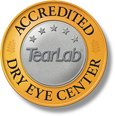 Dry Eye Disease is a common condition in which there is a deficiency in the quality and/or quantity of tears produced by the eyes. Tears perform many important functions for the eye including cleaning, lubrication, providing nutrition and maintaining a smooth surface to refract light and provide clear vision. A healthy tear film contains a complex balance of water, salts, mucin, and oils produced by glands on the eye and eyelids. If any of these components are out of balance, Dry Eye Disease symptoms can occur.
Dry Eye Disease is a common condition in which there is a deficiency in the quality and/or quantity of tears produced by the eyes. Tears perform many important functions for the eye including cleaning, lubrication, providing nutrition and maintaining a smooth surface to refract light and provide clear vision. A healthy tear film contains a complex balance of water, salts, mucin, and oils produced by glands on the eye and eyelids. If any of these components are out of balance, Dry Eye Disease symptoms can occur.
Dry Eye Disease Brochure Dry Eye Disease Products Dry Eye Self Test
Typical symptoms of Dry Eye Disease include dry or gritty sensation, scratchiness, itching, burning, pain, eyelid heaviness, intermittent blurred vision and intermittent tearing. Symptoms are usually worse later in the day, during prolonged use of the eyes, and in conditions of heat, wind and low humidity.
Many patients with Dry Eye Disease complain of intermittent tearing and watery eyes. Normally the lids produce a small amount of tears to keep the eyes lubricated and healthy. If this baseline tearing is of poor quality or insufficient quantity to keep the eyes healthy, a message will be sent to the brain to cause a reflex flow of tears from the main lacrimal gland. This reflex tearing results in a large volume of watery tears that accumulate in the eye or even run down the cheek. These symptoms may seem counterintuitive, but to prevent the watering, one must treat the dryness that triggers it.
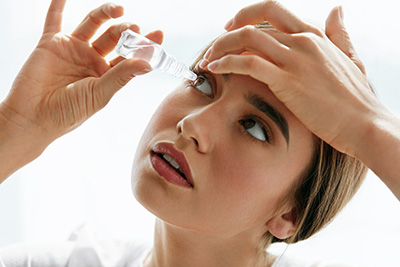
Dry Eye Disease has a wide range of severity and in some instances may be sight threatening. Treatment initially begins with artificial lubricants, usually drops, given 2 to 6 times a day.
Artificial tears work best when given on a scheduled basis rather than in response to symptoms. After beginning therapy with artificial tears, it may take several weeks of continuous use before long lasting improvement in symptoms is achieved. Not all artificial tears are created equal. Many have preservatives that can cause further irritation, especially if used frequently. Preserved artificial tears may be used up to 4-6 times a day. Preservative-free artificial tears should be used for sensitive eyes or when more frequent use is required. More severe cases of Dry Eye Disease may require the use of thicker ointments or gels. Hot compresses using a microwaveable heat mask may also be utilized to improve the function of the lubricating oil glands in the eyelids.
Consider supplementing your diet with omega-3 fatty acids. Recent studies have shown that omega-3 fatty acids can improve the tear quality and reduce dry eye symptoms. While omega-3 fatty acids can be found naturally in many food sources (i.e. wild salmon and herring), maximum benefits for adults are believed to be achieved with a daily dose of 2,000-4,000 mg. If you are not currently taking this supplement consider starting with 1,000 mg daily and work up to 2,000-4,000 mg per day.
Associated Eye Care offers a wide variety of drops, gels, ointments and vitamins for dry eye therapy. These are available for purchase in our optical shops as well as the AEC Online Marketplace.
Successful treatment begins with understanding the root cause of your symptoms. At Associated Eye Care, we use specialized testing to accurately determine the cause of your Dry Eye Disease and to develop a personalized treatment plan.

Associated Eye Care is proud to offer a series of meibography and tear film imaging technologies including. These non-invasive diagnostic tests capture live images of your tear film and measure lipid (oil) content and quality. The meibomian (oil) glands of the eyelids are also imaged to assess their anatomy and function. These tests will allow your doctor to determine if you should undergo treatment. The tearcheck® revolutionized Dry Eye Analyzer providers (9) tests with patented technology that allows you to evaluate and assess the health of the ocular surface within a few minutes.
ScoutPro Osmolarity system is used to measure osmolarity, which is the saltiness of your tears. As osmolarity in your tears increase, ocular surface cells become damaged. Using this device, your doctor will take a sample of tears from each eye to assess the quality of your tear film and the overall health of your ocular surface. ScoutPro Osmolarity system aids in accurate and early detection of Dry Eye Disease and provides information to follow disease severity over time.
Dry Eye Disease causes inflammation which contributes to bothersome symptoms and damage to the ocular surface. In some cases, inflammation is present before a patient experiences any Dry Eye Disease. InflammaDry is the first in-office test capable of detecting MMP-9, an inflammatory marker that is often elevated in the tears of patients with Dry Dye Disease. By recognizing elevated levels of MMP-9, InflammaDry is able to identify patients that may be missed with other dry eye testing methods.
Your doctor will perform a thorough slit lamp examination of the eyes and eyelids to assess for the presence and severity of Dry Eye Disease. Special stains may be used to better visualize the tears and ocular surface during your exam. Additional exam tests may be utilized to better identify the cause and severity of your Dry Eye Disease.
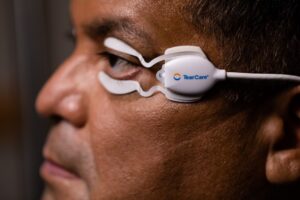
The TearCare System is a system designed to treat patients with dry eye disease due to meibomian gland dysfunction (MGD). The meibomian glands in your eyelids create the oil necessary to keep your eyes well-lubricated. When MGD is present, these oil glands don’t work correctly, resulting in inadequate oil in your tears.
When there is not enough oil in your tears, the tears may evaporate from the surface of your eyes too quickly. This can cause dry eyes. Common symptoms of dry eye disease include dryness, itching, redness, watering, or blurry vision.
The TearCare System is a treatment that uses heat and pressure to unblock the meibomian glands in your eyelids. Unblocking these oil glands allows them to work more normally and helps them create the oil that keeps your tears healthy.
The TearCare System is an easy, in-office procedure performed at Associated Eye Care. You’ll first have your eyelids prepared before having the SmartLids placed on your eyelids. While the SmartLids are on your eyelids, you’ll feel a combination of heat and pressure massaging your glands to unblock them. The treatment takes about 10 minutes to complete.
Many patients report a significant improvement in their symptoms after undergoing TearCare. The benefits often last for six months to a year. Patients may need to repeat treatments to continue experiencing relief.
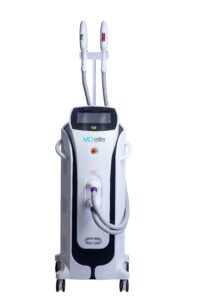
IPL stands for Intense Pulsed Light. IPL treats dry eye disease caused by meibomian gland dysfunction/disease (MGD) by decreasing inflammation in and around your eyes. IPL uses a very strong light source applied to your skin to remove inflammation and abnormal blood vessels as well as liquefying hardened oils clogging the meibomian glands within your eyelids.
How fast does it work? While many experience relief after their first IPL treatment, most people experience the most improvement after the third treatment as inflammation continues to recede and gland function returns.
How many treatments are required? The number of treatments varies based on severity, however, a minimum of 4 treatments have been shown to be effective in treating MGD.
Tears normally drain off of the eye and into the nasal cavity through a hole, or punctum, in each upper and lower eyelid. Permanent or temporary plugs may be placed in these holes to retain tears on the surface of the eye for a longer period of time.
These are eye drops made from your own blood serum, which are rich in healing properties and nutrients. The serum from your blood is diluted with a sterile, preservative-free solution to produce eye drops that are unique to you.
Amniotic membrane is harvested from the lining of human placenta and used for a variety of ocular conditions due to its anti-inflammatory and healing properties. While temporarily positioned over the eye, it can result in rapid healing of the ocular surface.
Associated Eye Care is proud to be one of the first practices in the country to provide these exciting, new forms of treatment. In addition, your doctor may recommend other dry eye therapies, such as therapeutic contact lenses or other prescription medications, as part of your personalized treatment plan.
At your Dry Eye Disease evaluation, you will undergo specialized testing in order to create a personalized treatment plan. Because we use sensitive testing instruments to identify the root cause of your symptoms, please follow the instructions below to avoid any delays in your care:
We are proud to be a TearLab Accredited Dry Eye Disease Center.
The evaluation and treatment of Dry Eye Disease is covered by most medical insurance plans. Depending on the details of your insurance plan, however, you may be personally responsible for some of the costs. This is especially likely if you have not yet met your annual deductible. We encourage you to contact your insurance company prior to your visit to determine your coverage and estimated out-of-pocket costs for the medical visit and following dry eye tests and treatments. We have included the CPT codes for typical testing and potential treatment options to help you make this determination.
Get relief today, pay tomorrow. Associated Eye Care offers 0% financing for 6 months through CareCredit. CareCredit is a healthcare credit card that allows patients to finance medical procedures not fully covered by insurance.
Did you know you can use your flexible spending account (FSA) or health savings account (HSA) for Dry Eye Disease treatment? Your flex dollars may expire at the end of the year. Use it before you lose it!
Our excellent team of providers is here to make sure your experience is a positive one. Whether it's our doctors or our professional staff, we promise to make every effort to give you the best possible care.
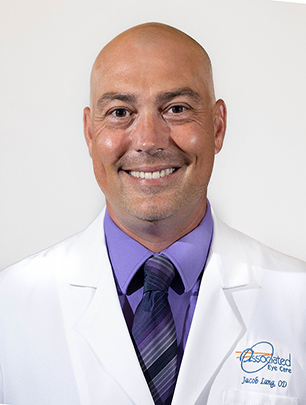
Comprehensive ExamDry Eye Disease
Dr. Lang joined Associated Eye Care in 2006. He received his Doctor of Optometry degree from The New England College of Optometry in Boston, MA. He was a member of Beta Sigma Kappa Optometric Honor Society, and received several awards for excellence in patient care and contact lens expertise. Dr. Lang then completed a cornea and specialty contact lens residency in Boston, MA. Through this additional education, he gained expertise in dry eye and ocular diseases, therapeutic contact lenses and surgical co-management. Dr. Lang has been involved in dry eye clinical research and FDA trials for many years including medications and therapeutic devices. He writes articles for several publications on the topic and is actively involved in lecturing to colleagues at various meetings locally and nationally. He is a Diplomat of the American Board of Optometry, a fellow of the American Board of Optometry and an Adjunct Clinical Faculty for the Illinois College of Optometry, The Ohio State University and Salus University. He is the Medical Director of Dry Eye Services at Associated Eye Care and the Co-Director for Associated Eye Care’s optometric residency program. He is actively involved in lecturing on eye care innovations and research.
Dr. Lang, his wife and son enjoy snowshoeing, skiing and spending time outdoors. He also enjoys playing golf, fly-fishing, and fly-tying.